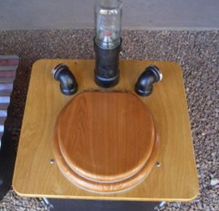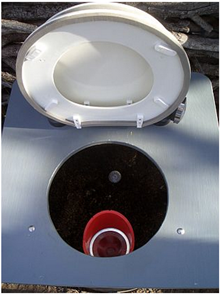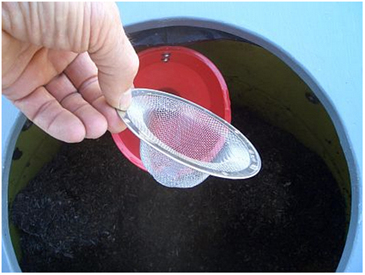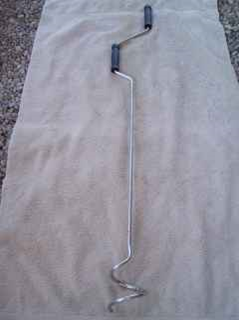Sun Valley Water & Wastewater Project
Composting Toilets
The barrel composting toilets were selected as an effective model for the simple and smaller composting toilets that will be incorporated within the smaller dome houses. The barrel composting toilet system is a batch type system in which fecal matter is separated from older fecal matter during the primary composting process [1]. The design will use a 55-gallon high density polyethylene barrel that will act as a composting chamber. For the estimated two people that will occupy each smaller dome house, there will be one active barrel and two aging barrels. Once the active barrel became full, the seat and ventilation assembly will be moved to an empty barrel. This will allow the once active barrel now to become an aging barrel and the empty barrel to become the new active barrel. Figure 4 demonstrates a 3 barrel system that will be appropriate for 2 adults using the toilet fulltime.

Figure 4: Three barrel composting toilet system with demand capacity suitable for 2 adults
The matter within the aging barrel will compost for a minimum of 4 months, during which time no additional fresh material is added. The barrel composting toilet system will keep all of the content within the system and there will be a zero leachate discharge to native soil [1]. The system will have full vector control, effective aeration, and moisture distribution. It will be constructed with durable, simple to clean and non-corrosive materials. The barrel system will be incorporated inside each of the dome houses. This type of toilet will allow complete separation of aging material from fresh material which provides an extra degree of safety. For a 2 adult system where a 3-barrel system will be incorporated, materials will cost approximately $325 [1]. Urine will be separated with the use of a urine diversion system to minimize the amount of liquid leachate produced within the system.
Components of Composting Toilet
The barrel composting toilet system will consist of four major components which will include a 55 gallon high-density polyethylene barrel, a toilet seat, a ventilation system and vector control [1]. The toilet seat will contain closed cell adhesive foam around the lid and seat to keep insects out of the toilet [1]. Figure 4 displays the main components of the barrel composting toilet system.

Figure 5: Top View of barrel composting toilet system
illustrates the top view of the composting toilet. This toilet will sit on top of the flooring with steps leading up to the top of the barrel.
Capacity Calculations
The total capacity for one standard high-density polyethylene barrel is 55 gallons. The effective capacity, which is also the true capacity, of one barrel allows for a 9” clearance between the top of the barrel and the top of the compost and therefore comes to be 41 gal/barrel [2]. The effective capacity, in days per barrel, came out to be 82 days which was calculated by dividing the effective capacity by the total volume (41 gallons per barrel/ 0.5 gallons per person per day). For the design capacity, the effective capacity plus 50% of the effective capacity (1.5 effective capacity) was calculated making the design capacity equal to 123 days/barrel which is approximately 4 months [2]. The system sizing is presented in Table 7.
Table 7: Barrel System Sizing
Cover Material Requirements
The absorbency of cover material is used to manage moisture within the composting toilet system. Because the composting toilets on the site will not utilize a leachate drain, the absorbency of the cover material is particularly important. A more absorbent cover material can be used to help dry out compost that is too wet. The results of a procedure to test the absorbency efficiency was done for 4 common cover materials which include sawdust, horse manure, wood shavings, and straw [3]. The results of that test are presented in Table 8 below.

Figure 6: Sample cover materials with water
Table 8: Cover Material Absorbency Results
As you can see, sawdust had the highest percentage of absorbency with 75% of water being absorbed and the least amount of water passing through the strainer of ¼ cup after 24 hours. Therefore, sawdust will likely be the absorbency material used for the composting toilets used on the site.
A maintenance worker will maintain the composting toilets including adjustments of the cover material, covering the aging barrels when they are full, desludging, and transporting the resulting compost matter.
Barrel Composting Toilet System: Urine Diversion System
The urine separation component is integrated with the barrel composting toilet system. The system is composed of 2 simple assembles; a urine diverter built into each barrel and a hose to transport urine to an approved drainage system. Each barrel requires one leachate chamber. The diverter created from a rapid fill funnel is available at auto shops. The drain hose is a 1/4” fuel line. The cause for the small hose diameter is due to the high dissolved minerals in urine that will precipitate over time on the inside of the drain pipes. The urine diverter will need to be rinsed thoroughly after each use which will require only ¼- ½ cup of water to clean the entire inside surface of the hose in which will prevent mineral formation. Furthermore, a stainless steel screen prevent mineral formation. Furthermore, a stainless steel screen will prevent clogging of the hose. Also, in the rare event that clogging occurs, a plumbing “snake” can be inexpensively constructed. Another advantage of the small diameter hose is that it prevents insects from getting into the toilet from the leaching chamber via the hose. A urine diversion system is displayed in the figures presented in Figure 7 below.


Figure 7: Urine Diversion System
Operation & Maintenance
ADEQ also requires that the following operation and maintenance tasks are completed [4]:
- To prevent potential fires and anaerobic conditions, the owner should provide sufficient mixing, ventilation, temperature control, moisture, and carbon material to the compost
- Replace the full composting toilets as necessary
- Only allow human waste, toilet paper and carbon additive to be placed inside composting toilets
- Ensure that the liquid product is either sprayed back onto composting waste material, removed by a person with the appropriately licensed vehicle, or that it is drained to an appropriate inceptor.
Mixing will be applied to the composting toilets by utilizing a crank, similar to the one shown below in Figure 8. Cranking will be applied about every two weeks and several times per week during hot weather to prevent odors [5]. This cranking allows of the appropriate amount of oxygen in the composting toilet. This oxygen is necessary to guarantee that the microbes within the compost can stay alive and perform their functions properly.
Additional operation and maintenance tasks include maintaining the appropriate carbon to nitrogen ratio, odor prevention, and disposal and reuse of compost.

Figure 8: Compost crank
Odor Prevention
If there is an odor problem, it may be an indication that one or more of the four essential elements of composting is out of balance. These four elements include the carbon/nitrogen ratio being out of balance, and the compost being too moist and not getting enough air. Each and every one of these things can be assisted by adding dry, high-carbon cover material followed by a thorough aeration of the compost. Within hotter climates, odor can be prevented by doing additional aeration several times per week. Additional large amounts of absorbent, carbonaceous material may be necessary for extremely wet compost.
Emptying out Barrels and Recommended Disposal and Reuse of Compost
After a minimum time of 4 months, the composted material is emptied from the aging barrel. There is a misconception that this process is unpleasant. However, this isn’t true since after 4 months the compost should be relatively lightweight material and the bucket should only be about 2/3 full. Furthermore, the aging barrel doesn’t have to be moved for emptying. The content should be removed with a round bladed shovel into a wheelbarrow. A tarp or large sheet that is at least 8 square feet should be should be set beside the aging barrel that requires emptying. The wheelbarrow is to be placed on the tarp beside the barrel. The rain cover and screen from the barrel is then removed. The shovel is then dug into the compost and emptied into the wheelbarrow. This is done until the barrel is relatively empty. Any spilled compost on the tarp should be gathered and placed into the wheelbarrow. The compost then should be spread in mulch basins around shrubs, vines or trees or deposited into an outdoor composting bin for further composting. The emptied barrow can now be used as an active barrow again and the cycle continues.
Regulations
The requirements specified by ADEQ for composting toilets that have less than 3000 gallons per day design flow (Section R18-9-E303) that pertain to the selected composting toilet alternative are listed below.
Requirements for Use of Composting Toilet
- The composting toilet may only be used if it handles wastewater according these specified regulations and if the graywater is separated and reused, and if the soil conditions support subsurface disposal.
Restrictions
- No more than 50 people may use the toilet per day.
- Only human excrement shall enter the composting toilet.
Performance Requirements
- Discharge of toilet contents to the native soil, except leachate, must be prevented. The leachate may drain to the wastewater disposal.
- The composting toilet must limit access to vectors of the contained waste.
- The wastewater must be disposed of into the subsurface to prevent the wastewater from surfacing.
Notice of Intent to Discharge Requirements
- Before the compost and wastewater materials are discharged, the owner must submit details and paperwork specified by ADEQ for both the composting toilet and wastewater.
Composting Toilet Design Requirements
- Composting chamber must be
- Watertight
- Constructed of durable materials that can that do not easily corrode or decay
- Prevent vectors from coming into contact with the system
- Prevent odors or toxic gas from escaping into the building with the use of airtight seals
Interceptor Requirements
- The system should include an interceptor where wastewater will pass through before it is dispersed in subsurface soil. This includes the kitchen wastewater that will not be incorporated into either the composting toilets or gray water system.
- The interceptor shall remove grease, oil, fibers, and solids from the wastewater supply.
- It must be covered to prevent mosquito and other vector access.
- The interceptor must be approximately 63 gallons in size.
References:
[1] Arizona Department of Environmental Quality. (2010). Blue Ribbon Panel on Water
Sustainability. [Online]. Available FTP:http://www.azwater.gov/AzDWR/waterManagement/documents/BRP_Final_Report-12-1-10.pdf
[2] (2013). Barrel Composting Toilet System: Capacity Calculations and System Sizing.
[Online].Available FTP:http://www.omick.net/composting_toilets/barrel_toilet_capacity.htm
[3] (2013). Barrel Composting Toilet System: Capacity Calculations and System Sizing.
[Online].Available FTP:http://www.omick.net/composting_toilets/barrel_toilet_capacity.htm
[4] (2013). Barrel Composting Toilet System: Owner Manual. [Online]. Available FTP:
http://www.omick.net/composting_toilets/barrel_toilet_owners_manual.htm
[5] Arizona Department of Environmental Quality. (2005). R-18-9-E303 General Permit:
Composting Toilet, Less Than 300 Gallons Per Day Design Flow. [Online]. Available FTP:
https://www.azdeq.gov/environ/water/engineering/download/rules/oss_403.pdf


